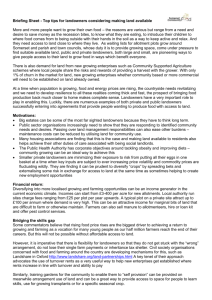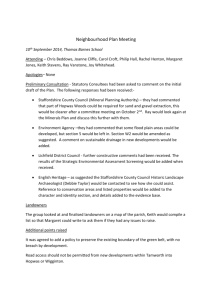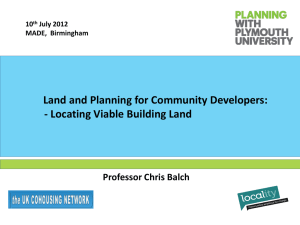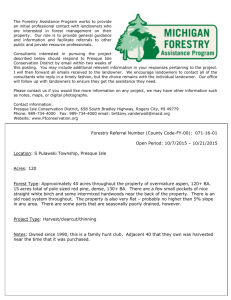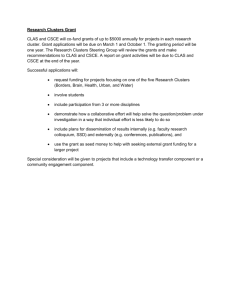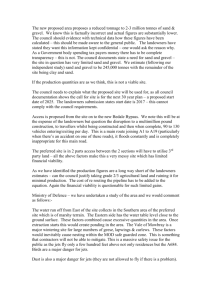ALTER flyer Community land auctions
advertisement
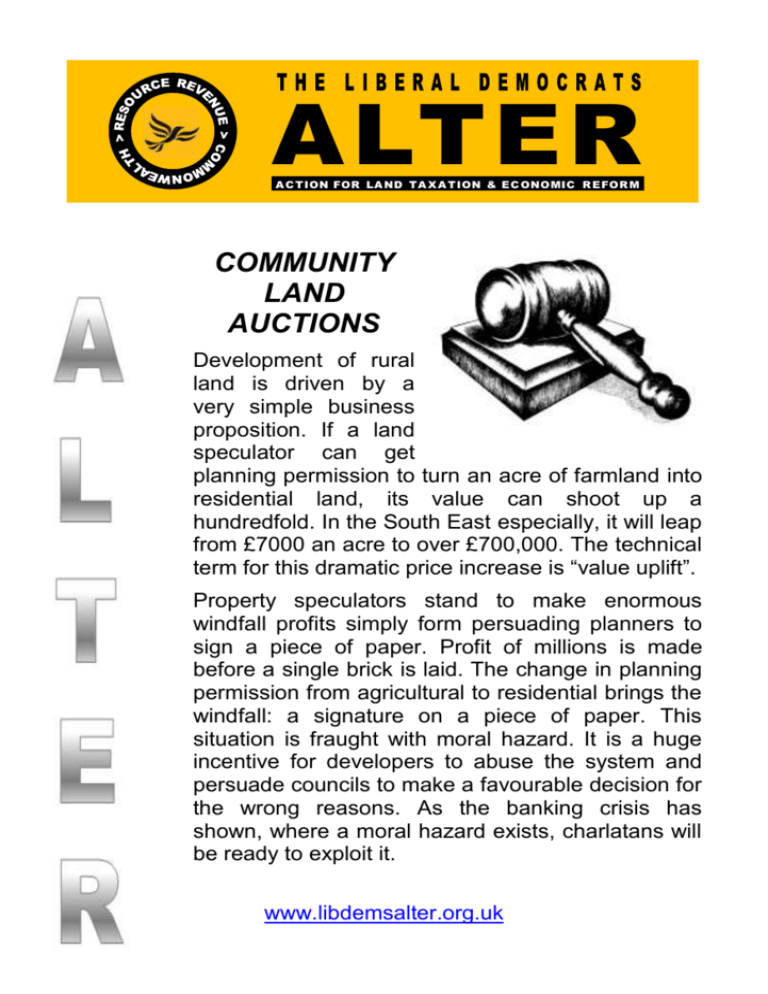
ALTER A C TION FOR LA ND TA X A TION & EC ONOMIC R EFOR M COMMUNITY LAND AUCTIONS Development of rural land is driven by a very simple business proposition. If a land speculator can get planning permission to turn an acre of farmland into residential land, its value can shoot up a hundredfold. In the South East especially, it will leap from £7000 an acre to over £700,000. The technical term for this dramatic price increase is “value uplift”. Property speculators stand to make enormous windfall profits simply form persuading planners to sign a piece of paper. Profit of millions is made before a single brick is laid. The change in planning permission from agricultural to residential brings the windfall: a signature on a piece of paper. This situation is fraught with moral hazard. It is a huge incentive for developers to abuse the system and persuade councils to make a favourable decision for the wrong reasons. As the banking crisis has shown, where a moral hazard exists, charlatans will be ready to exploit it. www.libdemsalter.org.uk ACTION FOR LAND TAXATIO N & ECONOMIC REFORM Can the windfall profit be recovered for the community, rather than falling into the hands of lucky land speculators? Can a moral hazard be removed? Can the availability of land for new homes be increased? Many economists, including Tim Leunig of centrist think tank CentreForum, think so. The solution is ingenious: the Community Land Auction (CLA). Excitingly, the coalition government is committed to trying this idea out, and it has gained support across the political spectrum. How does the CLA work? As today, the local authority determines how many homes are needed and provides an idea where they should be built, thus how many new building planning permissions need to be granted. The new idea of CLA is to use a special three stage process for granting planning permission, which ensures the community captures the value uplift In the CLA’s first stage, the local authority announces widely that it is inviting landowners to indicate for how much they are willing to sell their land. Land is eligible for consideration if it does not have planning permission for residential development. The landowners submit their offers as sealed bids, and the offer is irrevocable but time limited (say for 18 months). There is no compulsion on a landowner to submit an offer, and individual owners can name any price they like. There is no compulsion on the council to accept any particular offer. The second stage of the CLA takes place when the sealed bids are opened. The council assesses the rival bids according to existing criteria, e.g. impact and sustainability, but also it takes into account the price. The council then changes planning permission on the selected sites to allow development, according to the usual rules, and pays the owners their asking price. The “auction” takes place in the third and final stage. The council auctions its “right to buy” option to the highest bidder, along with planning permission which may be subject to conditions set by the council (e.g. social housing numbers). Since the land now Page | 2 ACTION FOR LAND TAXATIO N & ECONOMIC REFORM has residential planning permission, the council will be able to sell it at a much higher price than it paid. This “value uplift” accrues to the council, not the owners. For more details of this whole process see Tim Leunig’s excellent Centre Forum paper. Critics of CLAs say that landowners, deprived of the windfall profits available under the existing system will refuse to sell. This seems unlikely. After all, they could simply name an asking price which matches the profit they presently expect to make. The property speculator who does hold out for today’s hundredfold profit would be taking a double risk. First, that any other land owner who is willing to sell their land at agricultural rates could undercut them- say by offering their land at twice its value- while still making a very handsome profit. Second, that once the requirement for new housing is fulfilled, they would have no development opportunity for decades. Objections have been made that a conflict of interest will arise. Local councils will be in the position of both owning land and granting themselves planning permission. In fact this happens already, since councils are also landowners. For larger development there are safeguards which include recourse to independent inspectors. This situation is certainly no worse than the existing moral hazard that councillors and their officers are exposed to today, where private landowners have huge incentives to distort and corrupt the process by which planning permission is granted. CLAs are environmentally beneficial. Today’s enormous windfall profits from developing of greenfield sites confers landowners the financial muscle to distort the planning process to favour developments of greenfield sites and inhibit developments of brownfield sites. The potential profit margin available to landowners of greenfield sites allows them to finance the employment of highly skilled planning consultants who influence the council’s planning department far more effectively than the Page | 3 ACTION FOR LAND TAXATIO N & ECONOMIC REFORM amateur efforts of their “Nimby” opponents. To give a specific example, in the proposed Sandleford Park development in West Berkshire the council admitted that their professional planning officers had nine meetings with the consultants hired by the landowners over a two year period. The council was persuaded to classify large greenfield developments as especially “sustainable” since their scale allows best building practice, and to remove several brownfield sites from consideration; a position that implies that the whole country should be concreted over before any brownfield sites are re-used! CLAs could empower localism. Councils could use the profits from CLAs as they wish, for example to reduce local taxes. Tim Leunig’s paper waxes lyrical about “converting NIMBYs into IMBYs”, although this seems a rather pious hope. CLAs are entirely compatible with Land Value Taxation, and indeed has a different moral justification. Land Value Taxation can be thought of as a “service charge”- the community confers value to land by providing a system of property rights and a rule of law, and is entitled to recoup some of this benefit. CLAs aim to recover as much as possible of the windfall planning gain. Both aim to recover community created land value; both attack different facets of this problem. Liberal Democrat Action for Land Taxation and Economic Reform Author David Cooper Contact us at info@libdemsalter.org.uk One of a series of LVT information sheets, editor D Cooper ©ALTER MMXII Printed and published by P. Elderton, 86 Rothes Road Dorking, Surrey RH4 1LB Page | 4


